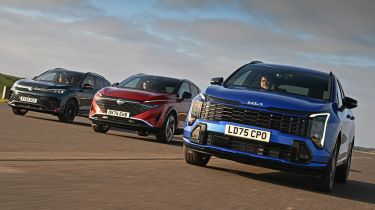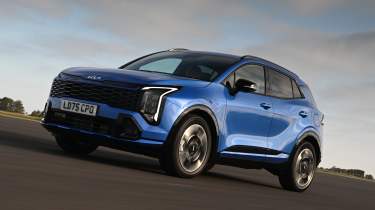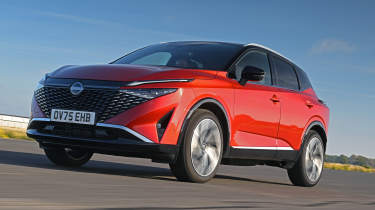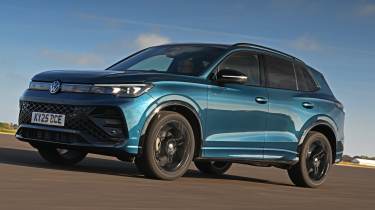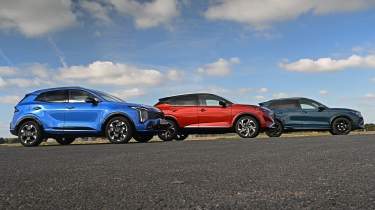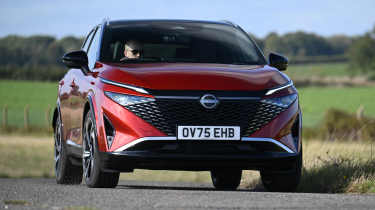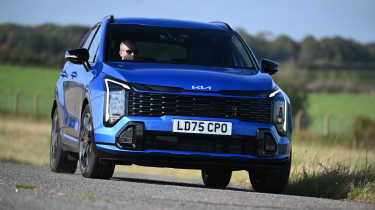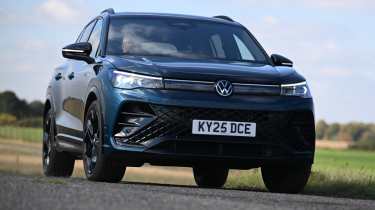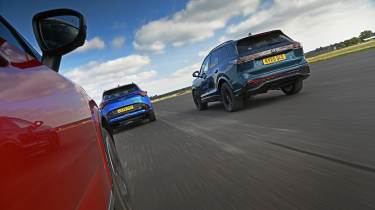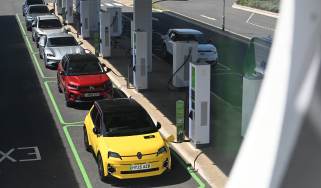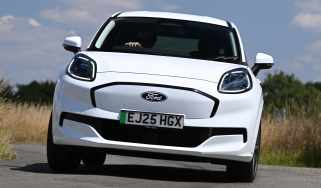Kia Sportage vs Nissan Qashqai vs Volkswagen Tiguan: SUV big-sellers do battle
The Kia Sportage, Nissan Qashqai and Volkswagen Tiguan are among the best-selling cars in the UK. Which deserves its popularity the most?
Mid-life car updates can take many forms. Some makers like to go after buyers’ hearts; sprinkling a little design magic inside and out to make an already appealing car just that little more fresh and modern.
A second approach is much rarer. From the outside, the car might look the same, but the brand instead decides to leave the updates to its engineers; tweaking an engine here, or revising the suspension set-up there.
Two of the biggest names in the current UK new-car landscape have taken these differing approaches for 2025. The Kia Sportage is the UK’s second best-selling car, behind the Ford Puma, and held top spot in September. It has recently been given a hefty cosmetic makeover.
The Nissan Qashqai was facelifted in 2024, but for this year, the country’s third best-selling car has a new hybrid powertrain that its manufacturer claims makes it the most efficient of its type in this segment.
To give these sales titans additional context, we’ve also brought along another of the UK’s most popular cars. The Volkswagen Tiguan, all new last year, currently sits ninth in the best-sellers list – and with its space, powertrains and badge appeal, it isn’t hard to see why.
Used - available now

2022 Nissan
Qashqai
15,623 milesAutomaticPetrol1.3L
Cash £16,197
2026 SEAT
Ateca
17,904 milesAutomaticPetrol1.5L
Cash £18,697
2022 Nissan
Qashqai
28,098 milesAutomaticPetrol1.3L
Cash £15,197
2024 SEAT
Arona
23,478 milesManualPetrol1.0L
Cash £13,697Did you know you can sell your car through Auto Express? We’ll help you get a great price and find a great deal on a new car, too.
Kia Sportage
| Model: | Kia Sportage |
| Price: | £36,925 |
| Powertrain: | 4cyl/1,598cc hybrid, 235bhp |
| 0-62mph: | 7.9 seconds |
| Test efficiency: | 43.8mpg |
| Official range: | 501 miles |
| Annual VED: | £195 |
The fifth generation of Kia’s family SUV isn’t just a huge hit with UK buyers – the Sportage is the brand’s most popular car in Europe, and globally too. Plenty would say that if it ain’t broke, don’t fix it, but that hasn’t stopped Kia from freshening things up, courtesy of a subtly revised look inside and out, plus a tweaked trim structure, aiming to keep the Sportage challenging at the top of the sales charts. The model we’re testing here is the mid-spec GT-Line trim with a hybrid powertrain – it costs £36,925.
Tester’s notes
Kia’s latest hybrid powertrain comes with adjustable regenerative braking, and the paddles behind the wheel allow the driver to adjust the strength of its response on the fly. We really like this level of flexibility, making the car very easy to control on inclines and when slowing down generally.
In its weakest setting, the Kia in effect coasts without motor regen; the strongest two of the four deceleration modes engage the brake lights when you lift off the accelerator. Level one regen feels closest to a standard petrol car’s engine braking.
Kia isn’t a manufacturer that goes in for optional extras very much, and that’s reflected in the Sportage’s trim line-up. If you want more kit, then you’ll need to step up the range from the base Pure model to the GT-Line and GT-Line S variants.
The latter is a big step up in cost, but adds plenty of extra tech, including adaptive LED headlights, a panoramic sunroof, ventilated front seats and heated rear seats, a powered tailgate, a Harman Kardon sound system, a head-up driver’s display, blind-spot detection and much more.
Nissan Qashqai
| Model: | Nissan Qashqai |
| Price: | £37,330 |
| Powertrain: | 3cyl/1,598cc, 201bhp |
| 0-62mph: | 7.6 seconds |
| Test efficiency: | 52.5mpg |
| Official range: | 774 miles |
| Annual VED: | £195 |
Nissan can claim to have invented the family SUV segment with the Qashqai, and it’s a formula that it has continued to refine in the almost 20 years since. In 2025, the third-generation car’s improvements focus on technical upgrades, with an overhaul of the e-Power hybrid technology aiming to boost performance, efficiency and refinement. The new system costs almost exactly the same as the outgoing set-up; it starts from £34,860, while our range-topping Tekna+ test car costs £43,210.
Tester’s notes
It isn’t just the casual observer who’d be hard pushed to spot the Qashqai’s exterior design tweaks; I had a hard job until they were pointed out. But that’s because they’re not about changing the car’s aesthetics, but boosting its aerodynamic efficiency.
The front bumpers get new wind deflectors to channel air around the sides of the Nissan more smoothly, while revised door mirrors also aim to achieve the same. Combined with a larger undertray beneath the car, the changes add up to a 1g/km reduction in CO2 emissions.
New cars are mandated to feature certain driver-assist systems that switch on every time the vehicle is started, so if these annoy you, then you must turn them off each time.
Fortunately, Nissan makes this easy to do. Similar in principle to Renault’s approach, it’s possible to program your preferred driver-assist arrangement in the infotainment menu, and then access this via two button presses on the steering wheel when the car starts. In other words, it’s much easier to switch the tech off than in rivals from Kia and Volkswagen.
Volkswagen Tiguan
| Model: | Volkswagen Tiguan |
| Price: | £39,230 |
| Powertrain: | 4cyl/1,498cc, 148bhp |
| 0-62mph: | 9.1 seconds |
| Test efficiency: | 39.5mpg |
| Official range: | 478 miles |
| Annual VED: | £195 |
We’re testing the Volkswagen Tiguan in range-topping R-Line trim, and unlike its rivals here, it has a mild-hybrid powertrain, so there’s less electrical assistance to work with the petrol engine. It’s priced from £42,135 on the road, but the car in these pictures featured an additional £9,070 of optional extras, including the Comfort Pack (£1,170), a panoramic sunroof (£1,415) and an electrically folding towbar with Trailer Assist (£1,125). Those features, and others, take the total price to £51,205.
Latest Volkswagen Tiguan deals
Tester’s notes
Front storage space is very impressive in the Tiguan, with two smartphone slots (both of which offer wireless charging in many models) plus a deep cubby space with moveable partitions for holding drinks.
This large central space has been made possible in part due to the steering column-mounted gear selector. Much like in the brand’s all-electric ID. models, the Tiguan’s stalk can be twisted to select either Drive or Reverse, while a button on the end engages Park. It doesn’t take long for this set-up to feel very intuitive.
Like much of the Volkswagen range, the Tiguan drives at its best when equipped with the optional adaptive dampers – part of a pack that VW calls “Dynamic Driving Package with Adaptive Chassis Control”. These greatly widen the spread of the Tiguan’s abilities, increasing body control through tighter turns, and ride comfort on more open roads.
Cars with the standard springs and dampers tend to fidget more over pretty much all road surfaces, but in their softest setting the adaptive dampers take the edge off.
Head-to-head
On the road
Little separates these three in terms of ride and handling. The Nissan’s ride is narrowly the best, but all are relaxing, while keeping composure in corners. The Qashqai’s powertrain also sets it apart; it has the smoothness, responsiveness and very nearly the refinement of a full EV. The Kia’s electrical power is strong, but the gearbox can be clunky. The Tiguan’s mild-hybrid tech feels a step down from the others.
Tech highlights
Whether under the bonnet or from the driver’s seat, the Qashqai feels the most hi-tech car here. Its hybrid powertrain is much more advanced than the Sportage or Tiguan’s set-up, with electrical power playing a much greater part than in either rival. Nissan’s Google-based infotainment is slick, loads quickly and looks great; VW’s, displayed on a huge screen, is second. Kia’s clunky set-up lags behind.
Price and running
The Qashqai’s e-Power system is the most efficient powertrain here. We averaged 52.5mpg on test, comfortably beating the Sportage (43.8mpg) and the Tiguan (39.5mpg). Not only is the VW set-up the thirstiest in the real world, it’s also quite expensive to buy – especially if you dive into the list of options. Show some restraint with those extras, however, and it’s the car that’s most resistant to depreciation of this trio.
Practicality
When it comes to interior space, the Tiguan is the one to have of this trio. Its cabin measurements are nearly identical to the Sportage’s, but its real advantage comes with its vast 652-litre boot. The Kia’s load bay is still impressive, at 587 litres, and it has the lowest load lip here, while rear passengers get reclining seat backs. The Qashqai’s 479-litre boot is still generous, but is the smallest of the three.
Safety
All three cars bagged a five-star rating from Euro NCAP when they were assessed, but the VW achieved that score against higher standards, given NCAP’s ever more stringent test procedures. Self-steering tech that can ease the strain of longer journeys is standard on all Sportage trims, while it’s a £1,000 extra on the Volkswagen. For the Nissan, it’s standard on all but the entry-level Acenta Premium.
Ownership
In our 2025 Driver Power customer satisfaction survey, Nissan finished 15th out of 31 manufacturers, beating both Kia (18th) and VW (27th). As ever, Kia presents the lure of a seven-year, 100,000-mile warranty, though – the other two cars only get three years’ cover. The Qashqai is the only model here to get three years’ breakdown cover; the other two come with a 12-month package.
Verdict
Winner: Nissan Qashqai
The Mk3 Qashqai has been crying out for a competitive powertrain since its launch. Four years on, the e-Power tech has matured with the responses, smoothness and very nearly the refinement of a fully electric car, but with the flexibility of a fuel-sipping petrol engine that allows for huge ranges between refills.
One of the very best-selling cars in the UK is now also one of the best family cars in the business.
Runner-up: Kia Sportage
While the Sportage might be more popular than the Qashqai with buyers, as an overall package, it just falls slightly short. If you consider cabin and boot space a dealbreaker, the Kia is still the car to have.
But in other areas, including the chassis and its hybrid powertrain, it can’t quite match the Nissan’s quality. Even so, its value, generous kit levels, smart interior design and strong performance – plus a seven-year warranty – mean that there’s a huge amount to like here.
Third: Volkswagen Tiguan
Third place might make Tiguan owners feel we’re doing the car a disservice, but in reality it has only narrowly fallen short of the class’s two best cars. In some ways, it’s the pick of this bunch for its superb practicality and strong overall driving experience.
But beyond the lure of the VW badge, we don’t feel like there’s enough reason to spend more on the Tiguan – a lot more if you delve into the options list – when both the Qashqai and the Sportage offer so much for the cash.
What we would choose
Kia sportage
- Best for equipment
Even the entry-level Sportage is loaded with standard equipment, with the range-topping GT-Line S furnished with all of the luxuries you’d ever want
Nissan Qashqai
- Best for efficiency
The Qashqai’s latest hybrid technology isn’t just smoother, more refined and slightly quicker than before, it also delivers excellent real-world efficiency
Volkswagen Tiguan
- Best for space
The Tiguan is huge inside, with both cabin and boot space ranking up with the class best. The Volkswagen’s interior is a very nice place to spend time, too
Prices and specs
| Our choice | Kia Sportage HEV GT-Line 1.6 T-GDi | Nissan Qashqai e-Power N-Connecta | Volkswagen Tiguan Match 1.5 eTSI |
| Price of our choice/as tested | £36,925/£37,600 | £37,330/£43,210 | £39,230/£51,205 |
| Powertrain and performance | |||
| Engine | 4cyl inline/1,598cc | 3cyl inline/1,598cc | 4cyl inline/1,498cc |
| HEV Motor | 64bhp | 201bhp/330Nm | 18bhp/56Nm |
| Power/ torque | 235bhp/265Nm | 201bhp/330Nm | 148bhp/250Nm |
| Transmission | Six-speed auto/fwd | Single speed/fwd | Seven-speed auto/fwd |
| 0-62mph/top speed | 7.9 secs/121mph | 7.6 secs/105mph | 9.1 secs/130mph |
| Fuel tank capacity/ battery capacity | 52 litres/1.49kWhh | 67 litres/2.1kWh | 55 litres/N/A |
| MPG (test/WLTP)/range | 43.8/50.4mpg/501 miles | 52.5/61.4mpg/774 miles | 39.5/46.1mpg/478 miles |
| CO2 | 128g/km | 103g/km | 140g/km |
| Dimensions | |||
| Length/wheelbase | 4,540/2,680mm | 4,425/2,665mm | 4,539/2,677mm |
| Width/height | 1,865/1,645mm | 1,835/1,625mm | 1,842/1,658mm |
| Rear knee room | 629-850mm | 601-844mm | 625-868mm |
| Rear headroom/elbow room | 985/1,531mm | 922/1,451mm | 980/1,502mm |
| Boot space (seats up/down) | 587/1,776 litres | 479/1,415 litres | 652/N/A litres |
| Boot length/width | 862/1,037mm | 855/1,084mm | 975/1,005mm |
| Boot lip height | 692mm | 756mm | 723mm |
| Kerbweight/towing weight | 1,665/1,510kg | 1,592/1,800kg | 1,616/1,800kg |
| Turning circle | 11.0 metres | 11.5 metres | 11.7 metres |
| Costs/ownership | |||
| Residual value (after 3yrs/36,000 miles) | £17,676/47.87% | £18,180/48.70% | £20,874/53.21% |
| Depreciation | £19,249 | £19,150 | £18,356 |
| Ins. group/quote/VED | 23/£685/£195 | 27/£662/£195 | 22/£574/£195 |
| Three-year service cost | £669 | £856 | £534 (2 years) |
| Annual tax liability std/higher rate | £2,186/£4,372 | £1,918/£3,836 | £2,550/£5,100 |
| Fuel cost (10,000 miles) | £1,409 | £1,176 | £1,563 |
| Basic warranty (miles)/recovery | 7yrs (100,000)/1yr | 3yrs (60,000)/3yrs | 3yrs (60,000)/1yr |
| Driver Power manufacturer position | 18th | 15th | 27th |
| NCAP Adult/child/ped./assist/stars | 87/86/66/72/5 (2022) | 91/91/70/95/5 (2021) | 83/88/84/78/5 (2024) |
| Equipment | |||
| Metallic paint/wheel size | £675/19 inches | £745/18 inches | £830/20 inches |
| Parking sensors/camera | F&r/360-degree | F&r/yes | F&r/yes |
| Spare wheel/Isofix points | Repair kit/two | Space saver/two | £370/three |
| Keyless entry & go/powered tailgate | Yes/yes | Yes/no | £1,140 (part of package) |
| Leather/heated seats | Yes/yes | No/yes | £2,230/yes |
| Screen size/digital dashboard | 12.3 inches/4.2 inches | 12.3 inches/12.3 inches | 12.9 inches/10.25 inches |
| Climate control/panoramic sunroof | Yes/yes | Yes/no | Yes/£1,385 |
| USBs/wireless charging | Four/yes | Four/no | Four/two |
| Wireless CarPlay/Android Auto | Yes/yes | Yes/yes | Yes/yes |
| Blind-spot warning/head-up display | Yes/Yes | Yes/no | Yes/£1,160 (part of package) |
| Adaptive cruise/steering assist | Yes/yes | Yes/yes | Yes/£1,000 (part of package) |
Looking for your next car? You can now search our nationwide dealer network for a choice of great cars on offer right now with new, used and leasing deals to choose from...

